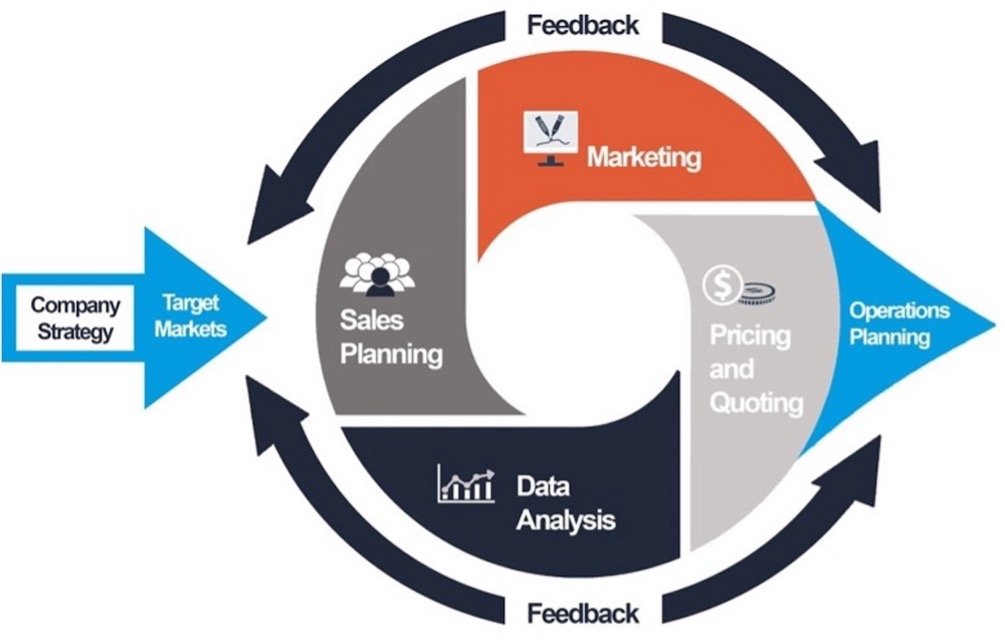A Revenue Roadmap: Mapping Out Your Sales Strategy
This is article is part of a series of monthly articles produced by Harbour Results for PMA’s MetalForming Business Edge e-newsletter. Click here to view the full collection of articles.
No matter how you look at it, the data is clear – formalizing your sales strategy and process delivers results. The Harvard Business Review states companies with a formal sales strategy are 60% more likely to achieve customer retention targets, and the Sales Management Association found organizations with a formal sales process experience a 13% decrease in sales cycle length and 18% more revenue growth.
Despite what the numbers show, many manufacturers move creating a sales strategy and process to the back burner. It only becomes an issue when the shop feels light or there is a shake up with current customers. The fact remains, you cannot sustain a business without sales, and having a defined sales process will deliver results. And, yes, it will take time to establish the process and see results, but your company will benefit in many ways.
Key Benefits of a Defined Sales Process
A well-defined, strategic sales plan can help with:
Defining Clear Goals, Objectives: Provides the sales team with clarity and ensures everyone understands what needs to be achieved and how success will be measured.
Aligning Business Objectives: Ensures the sales team is working toward the overall growth and success of the company.
Resource Allocation: Enables the sales team to prioritize activities and focus on the most promising opportunities, maximizing the return on investment.
Sales Forecasting: Outlining sales targets and timelines allows the company to plan inventory, production and other resources accordingly.
Sales Team Guidance: Outlining the sales processes, methodologies and tactics to be used, helps sales representatives perform more effectively.
Risk Management: Identifying potential risks and challenges, and having a contingency plan in advance allows the sales team to mitigate risks and more effectively adapt to changing market conditions.
Customer Focus: Considering the needs and preferences of target customers helps develop customer-centric strategies that enhance the customer experience and drive sales growth.
Continuous Improvement: By evolving over time, a plan provides a framework for ongoing evaluation and improvement of sales strategies and tactics based on feedback and results.
Where to Begin
There are a number of required pieces in developing a sales process. It all starts with a defined company strategy and target audience. It’s also critically important to understand what you do really well and the most profitable type of customers (i.e., who do you really want to work with). It’s incredibly difficult to sell “we do anything for anyone.” You need to understand your niche and the markets and customers needing your capabilities.
Gather the Data
Next, you need to gather data from inside your organization. Look at your data – number of converted leads, RFP hit rate, length of your average sales cycle, average profitability, profitability by customer – this will start shedding light on how your sales activities are performing and what metrics you will need to achieve to meet your business growth plans.
It’s also important to gather market intelligence in the industries you are targeting. Better understanding the marketplace will help you position your solutions while addressing the industry’s specific pain points.
Aligning Your Business
For a sales process to be effective, the entire business needs to be aligned. Sales needs to be aligned with operations to understand open capacity and what type of work is needed to fill the gaps. It’s important to identify and understand what projects are successful and why. By working together and communicating, the company will benefit by targeting and securing customers that drive profitability.
Furthermore, sales needs to collaborate with marketing – they should be in constant communication. Sales needs to share insights and information they gather from discussions with current and potential customers, and marketing needs to share data and information gathered from marketing activities – the website, social media, email campaigns, etc.
Reaching Your Target Audience
In today’s marketplace, marketing has gone from a nice-to-have activity to a have-to-have. In the past, manufacturers attended a few trade shows, built a lead list and then worked that list the rest of the year. Although events continue to be part of the mix, there are a number of other marketing tactics that can help generate leads and create opportunities to bid on business.
To start, audit your current marketing materials – are they old and outdated, do they communicate your niche, is there a call-to-action, are they working? Next, determine who within your organization will be responsible for marketing and/or if you need to outsource the activities. If no one is accountable for marketing, it probably won’t be effective.
Then you need to establish a budget. What are you going to invest in marketing activites? Once you have that, you can develop marketing objectives – how many leads you need to secure in a quarter or year – and establish a plan.
Establishing a strategic sales process and aligned marketing campaign will take time and effort. It can be a challenging task. However, if your company has established growth goals, it’s a necessary component to achieving them.
Interested in targeting your audience or building a strategic, marketing plan? Learn why manufacturers benefit from partnering with a marketing agency and connect with our partner WayPoint Marketing Communications.






